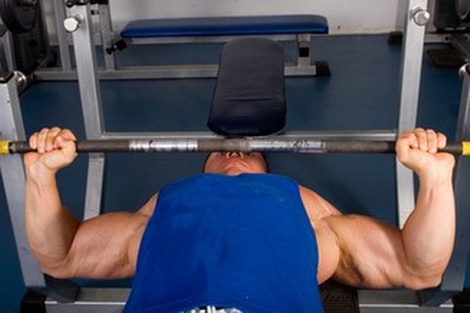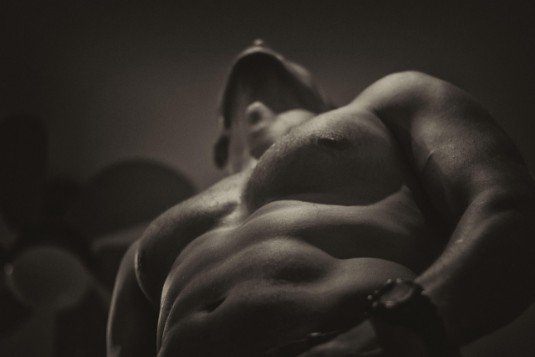Chest Training
More info : > How to series :
Training the pecs effectively
Of all the muscle groups that make up the human body, the chest is one of them that bodybuilders seem to prioritise more than any other. People ask me all the time how they can work the upper chest, the lowerchest, the inner chest, the outer chest, the upper middle and the lower outer. It is just confusing and absurd.
Building a thickly muscled, well developed chest is not that complicated. It may not happen as quickly for some compared to others, but it certainly is not so tricky. We will take a look at the structure of the pecs then you will see that training this group is really very easy.
The primary component of the chest is the large muscle named Pectoralis Major. It is only one muscle of many that is used to move the shoulder girdle and manipulate the arm (above the elbow). All of the muscle fibres that make up the Pectoralis Major run from the sternum and the sternal ends of the first 7 ribs, all the way to a small bump on side of your humerus bone called the greater tubercle.

This is almost the same exact point of where our lats attach to our arm. In fact, the fibres that attach to the arm run over the fibre of the lattissimus muscle. All of the fibers run in one direction, from the sternum to the humerus.
There are no facsial divisions or tendons that would constitute the distinction of a inner or outer chest. The Pectoralis major is all one piece.
There is no reason to try to find exercise that will increase the size of the inner part more than the outer because there aren't any that can do that.
An easier way to think of this is to find a rubber band and place it between the thumb and index finger of one hand. Let's imagine that your thumb is your sternum making the part of the rubber band closest to your thumb the "Inner Chest". With that said, you cannot move your thumb.
Now, by only moving your index finger, I want you to try to stretch out only the part closest to your thumb.
You can't do it! The whole band is going to stretch. And that is the same as how your pecs work.
There is also a small gathering of gathering of muscle that lie underneath the Pectoralis major, that are collectively called the Pectoralis Minor.
It starts from the middle of ribs 3-5 and attaches to the coracoid process that comes off of the scapula. That's because of its primary function it goes from the bottom up. Its primary function is only to depress the shoulder girdle. means if you to support your self on something with our your feet on the floor with your elbows locked out, the pec minor would be a player in forcing your shoulders down rather than letting them pinch your head off.
It is also involved in raising ribs 3-5. In other words, when you take a deep breath and your rib cage expands. Since it does not attachto the humerus, it does not have any involvement in actually moving the arm. Remember that the next time you hit the gym!
Now that we have a better understanding of what makes up the 'Chest' we can get into what the chest actually does.
Going back the Pectoralis Major, by definition, it flexes, adducts and medially rotates the arm (above the elbow). Flexing the arm mean that if you were to let your arm hang at your side, your chest would help you to raise it as if you were reaching for a door knob.
Adduction means to bring back. So if your arms were being held up like you were being crucified, the
Pectoralis major would help you to forcefully bring your arm back to your side. rotation is a complicated way to say turning your arm in towards your body so that your elbows flare out to the sides.
There is also Horizontal adduction. Which is much like regular adduction, however your arms are moving in a horizontal plane rather than a vertical one, for example clapping like a seal is horizontal adduction. And we have already talked about what the Pectoralis Minor does for us.
So now lets move on to some of the exercises that are most useful for these muscles in terms of adding thick muscle mass.
As we know how the muscle of the chest are put together and what it is they do for us in terms of movement, we can choose the most effective exercises.
The first exercise on the list is the flat barbell bench press.
This exercise is a adduction/horizontal adduction movement and by far the strongest movement that the Pectoralis Major can do.
When we look at this exercise, it is very important to only look at the arm in terms of from the elbow up. What happens below the elbow has no bearing on the muscle of the chest.
The flat or decline barbell bench press are the best overall chest exercises because they activate all parts of the pectorals.
This is of vital importance when trying to put on as much muscle in the shortest amount of time possible.
The next exercise on the list would be weighted dips.
This is also a triceps exercise- one of the primary functions of the chest was flexion of the arm, during the dip, our arms is in full extension at the bottom of the exercise.
Forget about what is going on below the elbow. The arm is in full extension. From a forced extension, your chest is the prime mover that has to bring it back into the neutral position by flexing the arm. The triceps are involved, but the chest is the dominating muscle group here. By leaning your torso forward about 15-20 degrees; you can take some of the tension off of your triceps and more on your chest.
Next would be the dumbell pullover. This hits the Pectoralis minor hard.
The minor group runs from the ribs up to the coracoid process on the scapula. It has no action on the arms. With the pull over, it is important to get a full stretch by taking your arms to at least parallel to the floor so we place the minor group under the greatest tension.
On the upward phase we need to remember to draw our shoulders towards our knees to depress the shoulder girdle. we have the incline barbell bench press.
Although there is not inner or outer chest, there is technically a 'upper' chest. This refers to the sternal head of the Pectoralis major. This is differentiated by a grouping of fibres of the Pectoralis major that attach to the clavicle as opposed to the sternum.
You can always tell people who do incline presses, and those who don't, these are the most effective exercise for adding muscle mass to the chest. There is no inner or outer aspect of the Pectoralis major, so stop wasting your time trying and asking!
I am constantly surprised by how many people insist on doing fly and cross-over exercises. I hope you can see why these types of exercises are don't have a place for adding mass to your chest. They are good for people who have weak or unstable shoulder joints and need to work on that area. However, if you don't havethese types of problems, then don't do them.
The stretch does not come into play for size increases. Your elbows will go to the exact same depth on a dumbell flye and a dumbell bench press. Yes, you will get a greater ROM than a barbell, but that is why we include dumbell bench press into the list of best exercises.
As for the stretch, there is no way that a different hand position will stretch the Pectoralis muscle. What is the stretch then? It's actually your biceps and the coricobrachiallis muscle.
The biceps muscle run from the gleno-humeral (shoulder) joint to just below the elbow. And the coricobrachiallis runs from the coracoid process to the middle of the humerus. This is the stretch that you feel. It is not the Pectoralis muscle.
The only thing these exercises do is lighten the load placed on the Pecs. Unless you can do flyes with as much weight as you can do presses with, you shouldn't be doing them.
Most of these exercises have been made up by poor personal trainers to keep their clients interested so they keep coming back. I just don't see any reason to waste time with those movements. I don't do them and chest development has never been a problem for me, just sticking with bench presses!
It's really very simple. There is absolutely no need to do 40 different exercises and you don't need a complex plan to hit the inner, outer and every fibre of the same muscle group.
Always ask yourself if what you and your friends are doing really makes sense. Sometimes what you 'feel' and what is really happening are not one in the same!
